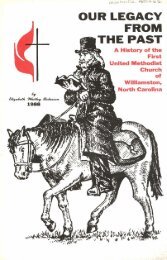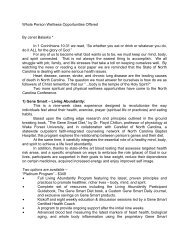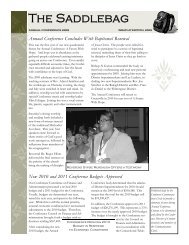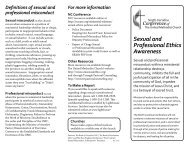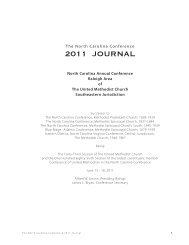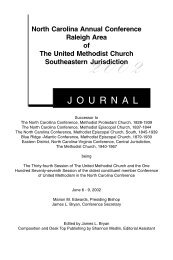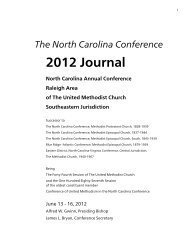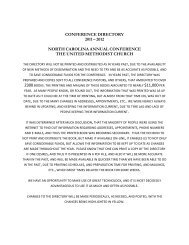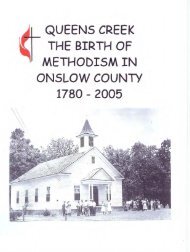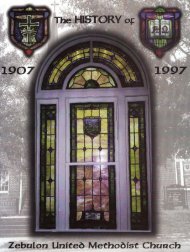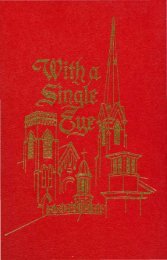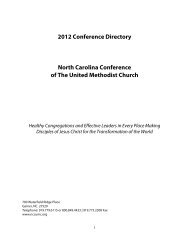Facing Tomorrow, Understanding Yesterday, A History of Orange ...
Facing Tomorrow, Understanding Yesterday, A History of Orange ...
Facing Tomorrow, Understanding Yesterday, A History of Orange ...
You also want an ePaper? Increase the reach of your titles
YUMPU automatically turns print PDFs into web optimized ePapers that Google loves.
The Sunday School Movement and<br />
<strong>Orange</strong> Church<br />
FACING TOMORROW, UNDERSTANDING YESTERDAY 11<br />
Although political problems made unity among Methodists in the United<br />
Statesalmost impossible for years, the Methodist Episcopal Church<br />
(North,South, and at <strong>Orange</strong>) continued to work for the advancement <strong>of</strong><br />
God'skingdom in their own ways. <strong>Orange</strong> Church, which served a<br />
predominantly agricultural community, adapted many <strong>of</strong> the<br />
denomination'sprograms to serve the special needs <strong>of</strong> its congregation.<br />
Oneactivity that played an important role in developing the <strong>Orange</strong><br />
Churchrole in the neighborhood was Sunday School.<br />
SundaySchool as such began in Great Britain in 1769 when a young<br />
Methodistwoman discovered that the program could be used to teach<br />
childrenhow to read and write while, at the same time, promoting a closer<br />
walkwith God. A Gloucester philanthropist began backing the program<br />
in1781,and by 1783, an article about the new church school caught] ohn<br />
Wesley'seye. With Wesley publicizing the Sunday School program and<br />
urgingthose who adhered to Methodism to begin such classes, the<br />
movementgrew within Methodist congregations. Bishop Asbury introducedthe<br />
movement in the United States in 1786, where the first classes<br />
wereheld in Hanover County, Virginia.<br />
Sunday Schools grew slowly in the United States until the annual<br />
conference<strong>of</strong> 1790 adopted a resolution that asked Methodists to "labor,<br />
asthe heart and soul <strong>of</strong> one man, to establish Sunday Schools in or near<br />
the place <strong>of</strong> public worship. Let persons be appointed by the bishop,<br />
elders,deacons, or preachers to teach (gratis) all that willattend and have<br />
acapacityto learn; from six o'clock in the morning until ten, and from two<br />
o'clockin the afternoon til six; where it does not interfere with public<br />
worship.The council shall compile a proper schoolbook, to teach them<br />
learningand piety."15<br />
Methodists soon put that statement into practice. In a time before<br />
publicschool educations were readily available for children, the Sunday<br />
Schoolsthat they established were designed to provide children with an<br />
educationand to keep them out <strong>of</strong> trouble as well as to teach the<br />
youngstersabout] esus. The multiple mission <strong>of</strong>the early Sunday Schools,<br />
however,was more than most teachers could handle. They soon abandonedthe<br />
idea <strong>of</strong> providing children with a general education and began<br />
using the Sunday hours to provide children solely with a religious<br />
education.<br />
Wehave no record <strong>of</strong> Sunday School at <strong>Orange</strong> Church prior to 1879,<br />
butweare confident there was a Sunday School here before that time. We<br />
dohave a roll book from 1879 and know that on April 6, 1879, thirteen<br />
scholarsand three teachers were on the roll. All were present on that Sunday School Group Picture circa 1900s



